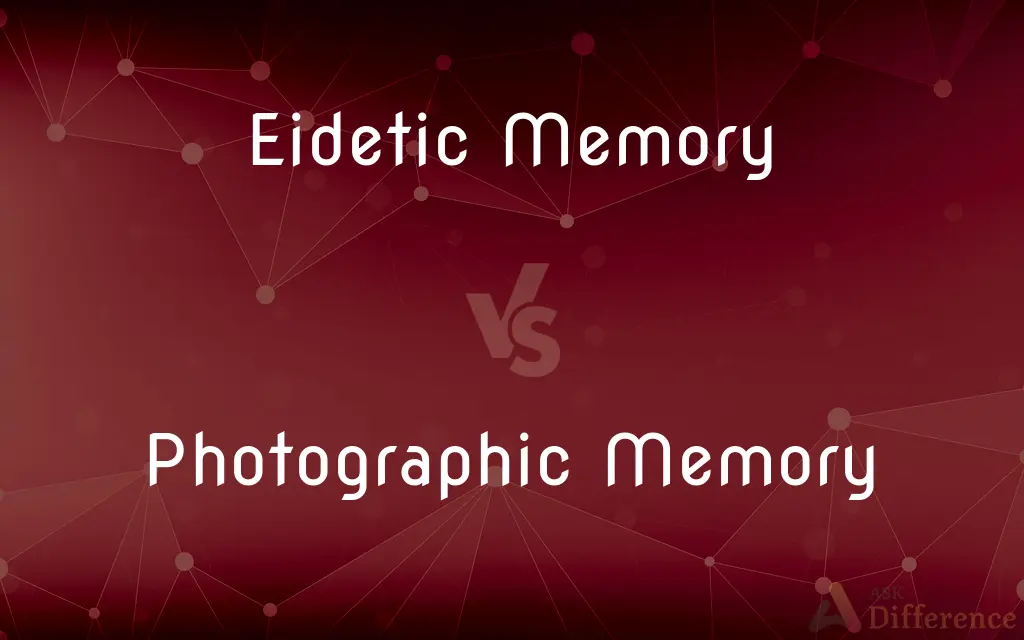Eidetic Memory vs. Photographic Memory — What's the Difference?
By Tayyaba Rehman — Published on October 6, 2023
Eidetic Memory refers to the ability to recall images, sounds, or objects in memory with high precision; Photographic Memory, often used interchangeably but more colloquially, suggests an exact "snapshot" recall of visual information.

Difference Between Eidetic Memory and Photographic Memory
Table of Contents
ADVERTISEMENT
Key Differences
Eidetic Memory is a term rooted in psychological research and refers to an individual's capability to recall images, sounds, or items with remarkable accuracy after only brief exposure. On the other hand, Photographic Memory is a more colloquial term, primarily denoting an ability to remember visual information as if one took a photo.
While instances of Eidetic Memory have been studied and observed, especially in children, the existence of a true Photographic Memory, where one can recall extensive details with picture-perfect accuracy, remains debated and is not widely accepted in scientific literature.
In popular culture, Eidetic Memory and Photographic Memory are often used interchangeably. However, professionals in cognitive science and psychology might prefer "eidetic" for its precise connotation.
People with Eidetic Memory often describe "seeing" the image as if it were still present, allowing them to study it in detail. Those claiming to possess Photographic Memory suggest they can recall visual details with extraordinary precision, akin to viewing a photograph.
While exact numbers are challenging to determine, it's generally believed that Eidetic Memory is rare but can be found especially among children. True Photographic Memory, as popularly imagined, might be even rarer or non-existent.
ADVERTISEMENT
Comparison Chart
Origin of Term
Scientific/psychological research
Colloquial/common usage
Type of Information Recalled
Images, sounds, or objects
Primarily visual information
Scientific Acceptance
Observed, especially in children
Not widely accepted as true "photo-like" recall
Description of Recall
"Seeing" the image as if still present
Recalling visual details as if viewing a photograph
Prevalence in Population
Rare, more common in children
Extremely rare or potentially non-existent
Compare with Definitions
Eidetic Memory
Retention of high-detail visual or auditory information.
His Eidetic Memory enabled him to recall the entire song after one listen.
Photographic Memory
Memory where one "photographs" detailed scenes.
His Photographic Memory was like having a built-in camera.
Eidetic Memory
Memory allowing "re-seeing" images in the mind's eye.
Thanks to her Eidetic Memory, she could view the scene again.
Photographic Memory
Ability to recall visuals with high precision.
Her Photographic Memory allowed her to draw the scene from memory.
Eidetic Memory
Ability to vividly recall images post-exposure.
She showcased her Eidetic Memory by describing the painting in detail.
Photographic Memory
Memory akin to taking mental snapshots.
With his Photographic Memory, he remembered layouts instantly.
Eidetic Memory
Exceptional recall capability, especially in children.
Children with Eidetic Memory often outperform peers in memory tasks.
Photographic Memory
Popular term for exceptional visual recall.
Novels often attribute detectives with Photographic Memory for investigative prowess.
Eidetic Memory
Remembrance characterized by vivid sensory details.
His Eidetic Memory helped him describe the texture and smell of the old book.
Photographic Memory
Supposed perfect visual retention capability.
Claims of true Photographic Memory are met with skepticism in scientific circles.
Common Curiosities
Are Eidetic Memory and Photographic Memory common traits?
Both are rare, with Eidetic Memory being observed especially in children. True Photographic Memory might be even rarer.
How does Photographic Memory differ from Eidetic Memory?
Photographic Memory suggests a perfect "snapshot" recall of visual info, while Eidetic Memory encompasses broader sensory recall.
Why is Eidetic Memory more accepted scientifically than Photographic Memory?
Eidetic Memory has been observed and studied, especially in children, while the concept of a perfect Photographic Memory remains more controversial.
Is Photographic Memory scientifically accepted?
The existence of a true Photographic Memory, as popularly imagined, is debated and not widely accepted in scientific literature.
How are these terms represented in media and culture?
Both are often used interchangeably in media, with characters possessing near-perfect recall for dramatic effect.
What is Eidetic Memory?
Eidetic Memory refers to the ability to recall images, sounds, or objects with high precision after brief exposure.
Can someone train themselves to have an Eidetic or Photographic Memory?
While memory techniques can enhance recall, developing true Eidetic or Photographic Memory isn't proven to be achievable through training.
Do all children with good memory have Eidetic Memory?
No, while some children might display impressive recall, it doesn't necessarily mean they possess Eidetic Memory.
Share Your Discovery

Previous Comparison
Active Voice vs. Passive Voice
Next Comparison
Nonprofit vs. Not-for-ProfitAuthor Spotlight
Written by
Tayyaba RehmanTayyaba Rehman is a distinguished writer, currently serving as a primary contributor to askdifference.com. As a researcher in semantics and etymology, Tayyaba's passion for the complexity of languages and their distinctions has found a perfect home on the platform. Tayyaba delves into the intricacies of language, distinguishing between commonly confused words and phrases, thereby providing clarity for readers worldwide.












































